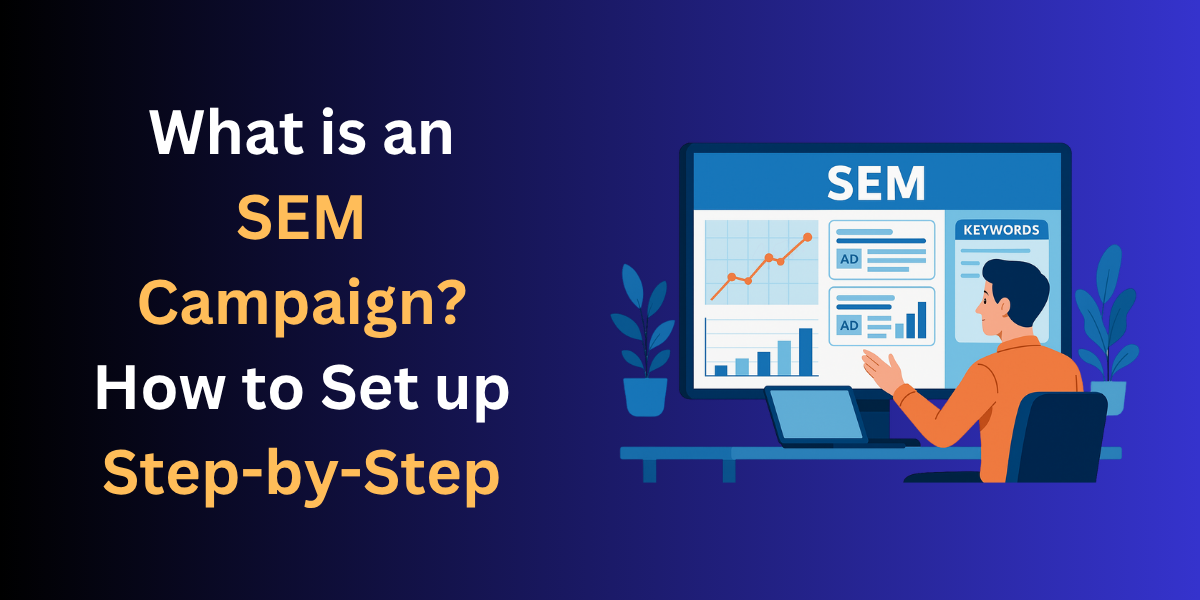What is a Search Engine Marketing Campaign? Step-by-Step
In the fast-changing world of digital marketing, search engine marketing (SEM) turns out to be one of the most powerful tools to obtain targeted traffic and conversion. Are you a small commercial enterprise owner, or might you be an advertising manager? Either way, knowing how to set up an (search engine marketing) SEM campaign will greatly act in favor of your brand being visible online.
Search Engine Marketing Definition
Search engine marketing refers to the application of paid advertisements, which show up on search engine results pages (SERPs). Also known as pay-per-click (PPC) advertising, these ads make it possible for a business to bid on some keywords that a user will type into a search engine, such as Google or Bing, in search of a certain product or service.
SEM is a powerful tool because it puts your business in front of potential customers at the very moment that they’re searching for what you offer. This is unlike the traditional form of advertising, which gives results that cannot be measured and options to target very general audiences.
Types of Search Engine Marketing Campaigns
SEM campaigns can be tailored depending upon your objectives and your audience. These are the main types:
- Search Ads: Text ads shown on SERPs whenever a user searches for specific keywords.
- Display Ads: On-the-web banner-type advertisements served across websites in the Google Display Network.
- Shopping Ads: Product-based ads that comprise an image, price, and merchant information—everything an e-commerce site needs.
- Video Ads: These video-based ads are an added bonus on sites such as YouTube, sometimes skippable, sometimes not, and can be placed before the actual video content.
- Remarketing Ads: Targeting users who had visited the site but had not converted.
- Local Service Ads: Promote local businesses by showcasing ads on the top of SERPs with a business rating and contact info.
How Does SEO Search Engine Marketing Work?
Search engine marketing works on bidding and through ad auctions. Here’s how:
- Advertiser selects keywords: You choose keywords relevant to your product/service.
- Bid is located: You bid how plenty you’re inclined to pay according to click (CPC).
- Ad Rank is calculated: Ad Rank is a formula involving your bid amount, ad quality (Quality Score), and the expected impact of extensions and formats.
- Ad placement: Higher Ad Rank manner better placement on the SERP.
- User clicks: Clicks result in payment.
How to Set Up an SEM Campaign: Step-by-Step
Step 1: Define Your Campaign Goals
Start with clear, measurable objectives. Common SEM goals include:
- Increasing website traffic
- Boosting product sales
- Generating leads
- Promoting a new service or offer
- Growing brand awareness
Defining your goal determines the campaign type, ad format, budget, and success metrics.
Step 2: Choose the Right Advertising Platform
Select the platform based on your audience and goals. Popular options:
- Google Ads (most widely used)
- Microsoft Advertising (for Bing and Yahoo)
- Amazon Ads (for e-commerce businesses)
- YouTube Ads (for video promotions)
For most businesses, Google Ads is the starting point due to its reach and powerful targeting features.
Step 3: Conduct Keyword Research
Targeting the right keywords is critical for campaign success.
Use Tools Like:
- Google Keyword Planner—Free tool within Google Ads.Provides keyword thoughts, seek quantity, and opposition stage.
- SEMrush—premium tool offering deep keyword insights, competitor analysis, and ad copy benchmarking.
- Ahrefs—a strong SEO tool that also offers PPC insights, including cost-per-click and traffic potential.
- Ubersuggest—Budget-friendly tool for beginners to explore keyword volume and competition.
Focus on a mix of:
- High intent keywords (e.g., “buy women’s shoes online”)
- Branded keywords (e.g., “Nike running shoes”)
- Long-tail keywords (e.g., “affordable waterproof hiking boots”)
Get More: Geo Targeting Ads
Step 4: Set a Realistic Budget
Determine how a whole lot you’re willing to spend daily or monthly. Factors to consider:
- CPC of your keywords
- Estimated clicks needed to convert
- Industry benchmarks (some industries like legal or insurance are more expensive)
- Lifetime value (LTV) of your customer
Example:
If your CPC is ₹50 and also you want 1,000 clicks/month → Monthly Budget = ₹50,000.
Start small, test performance, and scale gradually.
Focus on a mix of:
- High-intent keywords (e.g., “buy women’s shoes online”)
- Branded keywords (e.g., “Nike running shoes”)
- Long-tail keywords (e.g., “affordable waterproof hiking boots”)
Step 5: Write compelling ad copy
The ad copy has to grab attention and attract clicks.
Best Practices:
- Put the main keyword in your headline
- Describe your unique selling proposition (USP)
- Include numbers, offers, and a sense of urgency (e.g., “50% off” or “Limited Time”)
- Strong CTAs such as “Buy now,” “Get a free quote,” and “Learn more”
Example:
- Headline: Buy Designer Shoes—30% Off Today Only
- Description: Orders ship for free. Premium-quality shoes. Shop now before the offer ends!
Step 6: Drive traffic to an appropriate landing page
Your ad has to take the user to a super relevant, mobile-optimized landing page. Elements to consider:
- A headline that matches the ad
- Clear CTA (Buy Now, Sign Up, etc.)
- Trust signals (reviews, testimonials, secure payment badges)
- Speed of loading
- Minimal distractions (no unnecessary links)
A good landing page improves Quality Score, which reduces CPC and boosts your ad rank.
Step 7: Set Up Campaign Targeting
Fine-tuning your targeting ensures your ads reach the right audience.
Customize By:
- Location: Target by country, city, zip code, or radius around a location.
- Language: Choose the language your audience speaks.
- Device Type: Target desktops, mobile devices, or tablets based on user behavior.
- Ad Schedule: Run ads only during business hours or when your audience is most active.
This helps control costs and improves engagement rates.
Get More: How to Build High Quality Backlinks
Step 8: Launch Your Campaign and Monitor Results
After reviewing your campaign settings, launch it!
Use Google Ads Dashboard to track:
- Clicks
- Impressions
- CTR (Click-Through Rate)
- CPC (Cost Per Click)
- Conversions
- ROAS (Return on Ad Spend)
Install Google Analytics and conversion tracking tags to see what users do after clicking your ad.
Step 9: Optimize Your SEM Campaign
Search Engine Marketing is not “set it and overlook it.” Continuous optimization is top.
Optimization Tactics:
- Pause low-performing keywords
- A/B test ad copy and landing pages
- Adjust bids for better-performing keywords
- Use negative keywords to avoid irrelevant traffic
- Improve Quality Score with better ad relevance and touchdown pages
- Refine targeting based totally on overall performance data (region, device, time)
Use reports and insights to tweak campaigns weekly or biweekly.
Conclusion
A successful SEM campaign is both an art and a science—it requires a balance of strategy, tools, copywriting, data analysis, and continuous testing. From choosing the right keywords to crafting compelling ad copy and tracking ROI, every step counts toward achieving your business goals.
If you’re new to SEM or need expert guidance to scale your results, partnering with a professional team can make all the difference. Metaloop Marketing, a leader in search engine marketing surat, offers cutting-edge (Search Engine Marketing) SEM campaign management designed to maximize ROI while keeping your costs in check. Their experience with keyword strategy, ad optimization, and competitive analysis can help you get the best return from every click.



Write a Comment